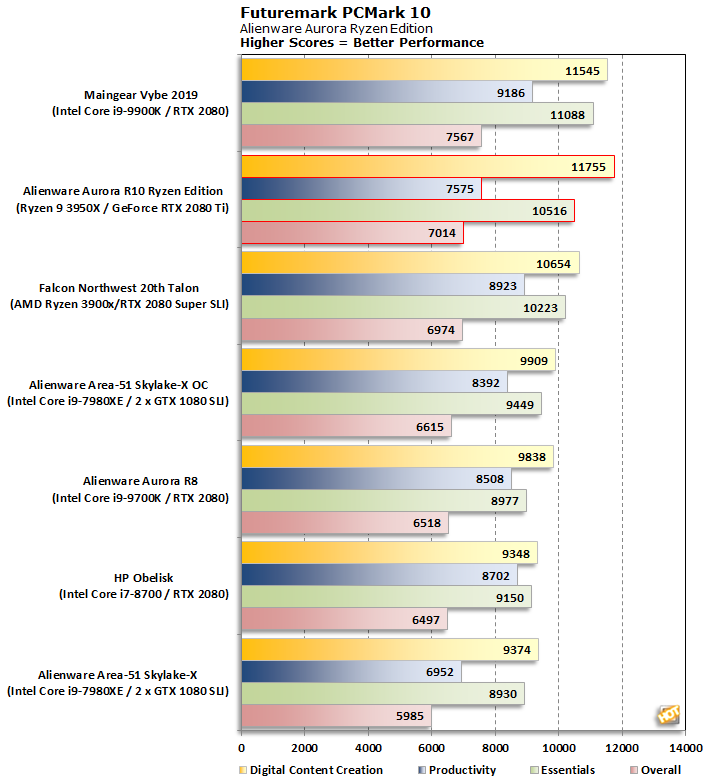Alienware Aurora AMD Ryzen Edition: 3DMark FireStrike Ultra and TimeSpy
|
UL Benchmarks' suite of tests have been the go-to system benchmarks since the late ‘90s. We ran the Aurora through PCMark 10, which is designed to gauge the system performance in everyday use case scenarios with GPU acceleration-enabled, while 3DMark tests its gaming chops.

PCMark seems to favor Intel CPUs in the Productivity and Digital Content Creation tests. Back when we equalized thread counts and core speeds to see if Zen 2 had really caught up to Intel's latest and greatest, we found that Intel still had a slight IPC edge over AMD. Still, the Aurora Ryzen Edition's many cores win the day over everything but the Maingear Vybe. In fact, the Aurora posted the very best Digital Content Creation score out of the whole bunch. Even if it didn't take the overall victory; the Aurora can still get work done in a big hurry.
|
3DMark is a synthetic GPU benchmark for assessing graphics performance and computational prowess in physics simulations. 3DMark supports both DX11 and DX12, depending on the particular test being run, which makes it handy for testing GPUs of various performance levels. We used the FireStrike test's Extreme preset and the standard TimeSpy benchmark to push the Alienware Aurora Ryzen Edition. FireStrike's Extreme preset runs this punishing test at 2560x1440. We're reporting overall scores, subtest scores, and each test's frames per second average to see how the Aurora performs.

We're starting with the overall 3DMark score and the system's graphics score here. Since FireStrike doesn't use any ray tracing effects, Nvidia's Pascal architecture and the newer Turing cards are on somewhat equal footing. The GeForce RTX 2080 Ti might be the very fastest single graphics card on the planet, but it still can't keep up with a pair of last-generation GeForce GTX 1080 Ti cards in SLI, at least according to this benchmark test. That's not a slight against the Aurora, since configurations of it with dual cards in SLI are also available of course, but in our test sample the single fastest card has to settle for fourth place.

When we look at the individual tests, we see that the single GeForce RTX 2080 Ti on board the Alienware Aurora R10 is again the fastest single card around, but it comes in behind an awful lot of SLI combos on our list. In the combined test, which features a lot of graphical eye candy mixed in with a heavy physics compute load, the Aurora places higher up on our list, passing several systems with dual graphics cards in SLI to get up to the middle of the pack. This is a heavy load, and the Aurora's single graphics card has a lot to be proud of here, if graphics cards felt emotions.

The physics test tells a very different story, however. The Aurora's Ryzen 9 3950X is top dog in this test, besting even the mighty Threadripper 2950X by 15%. You've got to come down to the fourth place Maingear Vybe to find system with a CPU from Intel, though. Intel's CPUs might generally have better single core performance, but the additional cores in the Aurora Ryzen Edition win the day, coming in around 20% faster than the Maingear.
|
Time Spy is 3DMark's DirectX 12 test. This test also has multiple presets, but the standard Time Spy stresses even a fast gaming desktop pretty heavily on its own, so that's what we stuck with.

Overall, the Aurora takes the cake in this test, since it doesn't have to contend with any SLI systems. This test doesn't use any ray tracing effects, but the Aurora's GeForce RTX 2080 Ti still thumped the older Pascal-based GeForce GTX 1080 Ti by around 35%. This Alienware system doesn't mess around, beating even our GeForce RTX 2080 Ti testbed with its 18-core Core i9-7980XE's overall score by around 5%.
These tests are awfully pretty to watch and a reasonable point of comparison in the hardware world, but you can't play 3DMark. So next up we'll check out some in-game performance for the Aurora R10 Ryzen Edition.






